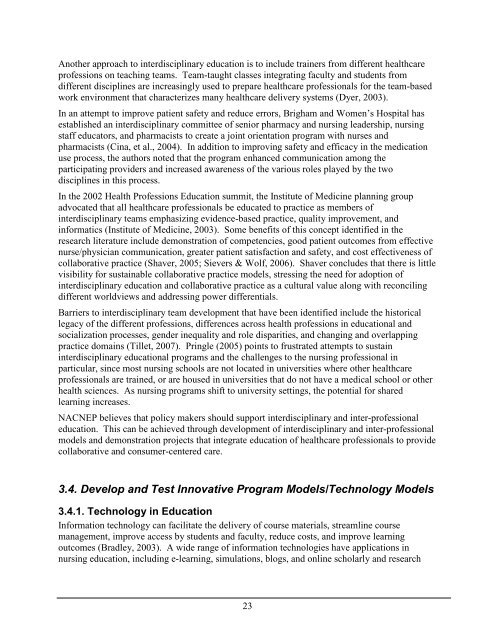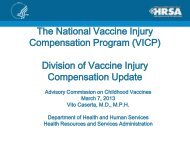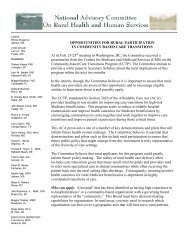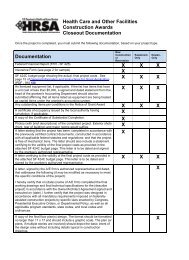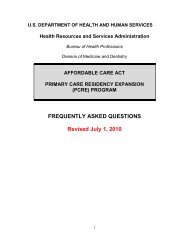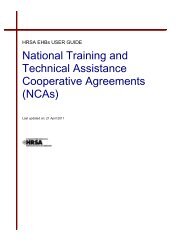Addressing New Challenges Facing Nursing Education ... - HRSA
Addressing New Challenges Facing Nursing Education ... - HRSA
Addressing New Challenges Facing Nursing Education ... - HRSA
Create successful ePaper yourself
Turn your PDF publications into a flip-book with our unique Google optimized e-Paper software.
Another approach to interdisciplinary education is to include trainers from different healthcare<br />
professions on teaching teams. Team-taught classes integrating faculty and students from<br />
different disciplines are increasingly used to prepare healthcare professionals for the team-based<br />
work environment that characterizes many healthcare delivery systems (Dyer, 2003).<br />
In an attempt to improve patient safety and reduce errors, Brigham and Women’s Hospital has<br />
established an interdisciplinary committee of senior pharmacy and nursing leadership, nursing<br />
staff educators, and pharmacists to create a joint orientation program with nurses and<br />
pharmacists (Cina, et al., 2004). In addition to improving safety and efficacy in the medication<br />
use process, the authors noted that the program enhanced communication among the<br />
participating providers and increased awareness of the various roles played by the two<br />
disciplines in this process.<br />
In the 2002 Health Professions <strong>Education</strong> summit, the Institute of Medicine planning group<br />
advocated that all healthcare professionals be educated to practice as members of<br />
interdisciplinary teams emphasizing evidence-based practice, quality improvement, and<br />
informatics (Institute of Medicine, 2003). Some benefits of this concept identified in the<br />
research literature include demonstration of competencies, good patient outcomes from effective<br />
nurse/physician communication, greater patient satisfaction and safety, and cost effectiveness of<br />
collaborative practice (Shaver, 2005; Sievers & Wolf, 2006). Shaver concludes that there is little<br />
visibility for sustainable collaborative practice models, stressing the need for adoption of<br />
interdisciplinary education and collaborative practice as a cultural value along with reconciling<br />
different worldviews and addressing power differentials.<br />
Barriers to interdisciplinary team development that have been identified include the historical<br />
legacy of the different professions, differences across health professions in educational and<br />
socialization processes, gender inequality and role disparities, and changing and overlapping<br />
practice domains (Tillet, 2007). Pringle (2005) points to frustrated attempts to sustain<br />
interdisciplinary educational programs and the challenges to the nursing professional in<br />
particular, since most nursing schools are not located in universities where other healthcare<br />
professionals are trained, or are housed in universities that do not have a medical school or other<br />
health sciences. As nursing programs shift to university settings, the potential for shared<br />
learning increases.<br />
NACNEP believes that policy makers should support interdisciplinary and inter-professional<br />
education. This can be achieved through development of interdisciplinary and inter-professional<br />
models and demonstration projects that integrate education of healthcare professionals to provide<br />
collaborative and consumer-centered care.<br />
3.4. Develop and Test Innovative Program Models/Technology Models<br />
3.4.1. Technology in <strong>Education</strong><br />
Information technology can facilitate the delivery of course materials, streamline course<br />
management, improve access by students and faculty, reduce costs, and improve learning<br />
outcomes (Bradley, 2003). A wide range of information technologies have applications in<br />
nursing education, including e-learning, simulations, blogs, and online scholarly and research<br />
23


